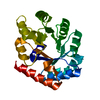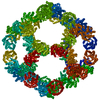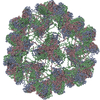+ Open data
Open data
- Basic information
Basic information
| Entry | Database: PDB / ID: 7b3y | ||||||
|---|---|---|---|---|---|---|---|
| Title | Structure of a nanoparticle for a COVID-19 vaccine candidate | ||||||
 Components Components | Fibronectin binding protein,2-dehydro-3-deoxyphosphogluconate aldolase/4-hydroxy-2-oxoglutarate aldolase | ||||||
 Keywords Keywords | VIRUS LIKE PARTICLE / SARS-CoV-2 / SpyTag / VLP / Receptor-binding domain / vaccine / COVID-19 / SpyCatcher / nanocage / icosahedral / nanoparticle / coronavirus / mi3 | ||||||
| Function / homology |  Function and homology information Function and homology informationD-galactonate catabolic process / 2-dehydro-3-deoxy-6-phosphogalactonate aldolase activity / cell adhesion / extracellular region Similarity search - Function | ||||||
| Biological species |  Streptococcus pyogenes serotype M49 (bacteria) Streptococcus pyogenes serotype M49 (bacteria)  Thermotoga maritima (bacteria) Thermotoga maritima (bacteria) | ||||||
| Method | ELECTRON MICROSCOPY / single particle reconstruction / cryo EM / Resolution: 3.7 Å | ||||||
 Authors Authors | Duyvesteyn, H.M.E. / Stuart, D.I. | ||||||
| Funding support |  United Kingdom, 1items United Kingdom, 1items
| ||||||
 Citation Citation |  Journal: Nat Commun / Year: 2021 Journal: Nat Commun / Year: 2021Title: A COVID-19 vaccine candidate using SpyCatcher multimerization of the SARS-CoV-2 spike protein receptor-binding domain induces potent neutralising antibody responses. Authors: Tiong Kit Tan / Pramila Rijal / Rolle Rahikainen / Anthony H Keeble / Lisa Schimanski / Saira Hussain / Ruth Harvey / Jack W P Hayes / Jane C Edwards / Rebecca K McLean / Veronica Martini / ...Authors: Tiong Kit Tan / Pramila Rijal / Rolle Rahikainen / Anthony H Keeble / Lisa Schimanski / Saira Hussain / Ruth Harvey / Jack W P Hayes / Jane C Edwards / Rebecca K McLean / Veronica Martini / Miriam Pedrera / Nazia Thakur / Carina Conceicao / Isabelle Dietrich / Holly Shelton / Anna Ludi / Ginette Wilsden / Clare Browning / Adrian K Zagrajek / Dagmara Bialy / Sushant Bhat / Phoebe Stevenson-Leggett / Philippa Hollinghurst / Matthew Tully / Katy Moffat / Chris Chiu / Ryan Waters / Ashley Gray / Mehreen Azhar / Valerie Mioulet / Joseph Newman / Amin S Asfor / Alison Burman / Sylvia Crossley / John A Hammond / Elma Tchilian / Bryan Charleston / Dalan Bailey / Tobias J Tuthill / Simon P Graham / Helen M E Duyvesteyn / Tomas Malinauskas / Jiandong Huo / Julia A Tree / Karen R Buttigieg / Raymond J Owens / Miles W Carroll / Rodney S Daniels / John W McCauley / David I Stuart / Kuan-Ying A Huang / Mark Howarth / Alain R Townsend /   Abstract: There is need for effective and affordable vaccines against SARS-CoV-2 to tackle the ongoing pandemic. In this study, we describe a protein nanoparticle vaccine against SARS-CoV-2. The vaccine is ...There is need for effective and affordable vaccines against SARS-CoV-2 to tackle the ongoing pandemic. In this study, we describe a protein nanoparticle vaccine against SARS-CoV-2. The vaccine is based on the display of coronavirus spike glycoprotein receptor-binding domain (RBD) on a synthetic virus-like particle (VLP) platform, SpyCatcher003-mi3, using SpyTag/SpyCatcher technology. Low doses of RBD-SpyVLP in a prime-boost regimen induce a strong neutralising antibody response in mice and pigs that is superior to convalescent human sera. We evaluate antibody quality using ACE2 blocking and neutralisation of cell infection by pseudovirus or wild-type SARS-CoV-2. Using competition assays with a monoclonal antibody panel, we show that RBD-SpyVLP induces a polyclonal antibody response that recognises key epitopes on the RBD, reducing the likelihood of selecting neutralisation-escape mutants. Moreover, RBD-SpyVLP is thermostable and can be lyophilised without losing immunogenicity, to facilitate global distribution and reduce cold-chain dependence. The data suggests that RBD-SpyVLP provides strong potential to address clinical and logistic challenges of the COVID-19 pandemic. | ||||||
| History |
|
- Structure visualization
Structure visualization
| Movie |
 Movie viewer Movie viewer |
|---|---|
| Structure viewer | Molecule:  Molmil Molmil Jmol/JSmol Jmol/JSmol |
- Downloads & links
Downloads & links
- Download
Download
| PDBx/mmCIF format |  7b3y.cif.gz 7b3y.cif.gz | 55.8 KB | Display |  PDBx/mmCIF format PDBx/mmCIF format |
|---|---|---|---|---|
| PDB format |  pdb7b3y.ent.gz pdb7b3y.ent.gz | 36 KB | Display |  PDB format PDB format |
| PDBx/mmJSON format |  7b3y.json.gz 7b3y.json.gz | Tree view |  PDBx/mmJSON format PDBx/mmJSON format | |
| Others |  Other downloads Other downloads |
-Validation report
| Summary document |  7b3y_validation.pdf.gz 7b3y_validation.pdf.gz | 750.9 KB | Display |  wwPDB validaton report wwPDB validaton report |
|---|---|---|---|---|
| Full document |  7b3y_full_validation.pdf.gz 7b3y_full_validation.pdf.gz | 751.6 KB | Display | |
| Data in XML |  7b3y_validation.xml.gz 7b3y_validation.xml.gz | 13.5 KB | Display | |
| Data in CIF |  7b3y_validation.cif.gz 7b3y_validation.cif.gz | 18.3 KB | Display | |
| Arichive directory |  https://data.pdbj.org/pub/pdb/validation_reports/b3/7b3y https://data.pdbj.org/pub/pdb/validation_reports/b3/7b3y ftp://data.pdbj.org/pub/pdb/validation_reports/b3/7b3y ftp://data.pdbj.org/pub/pdb/validation_reports/b3/7b3y | HTTPS FTP |
-Related structure data
| Related structure data |  11997MC M: map data used to model this data C: citing same article ( |
|---|---|
| Similar structure data |
- Links
Links
- Assembly
Assembly
| Deposited unit | 
|
|---|---|
| 1 | x 60
|
- Components
Components
| #1: Protein | Mass: 36000.715 Da / Num. of mol.: 1 Source method: isolated from a genetically manipulated source Details: Model just contains mi3 cage component of VLP. Note that the Spy and RBD (spy tag and RBD are omitted from the sequence) are are not included in the model. The spycatcher003-mi3 can be found ...Details: Model just contains mi3 cage component of VLP. Note that the Spy and RBD (spy tag and RBD are omitted from the sequence) are are not included in the model. The spycatcher003-mi3 can be found on genbank with code MT945417 and that of the SpyTag-RBD at MT945427.,Model just contains mi3 cage component of VLP. Note that the Spy and RBD (spy tag and RBD are omitted from the sequence) are are not included in the model. The spycatcher003-mi3 can be found on genbank with code MT945417 and that of the SpyTag-RBD at MT945427. Source: (gene. exp.)  Streptococcus pyogenes serotype M49 (strain NZ131) (bacteria), (gene. exp.) Streptococcus pyogenes serotype M49 (strain NZ131) (bacteria), (gene. exp.)   Thermotoga maritima (strain ATCC 43589 / MSB8 / DSM 3109 / JCM 10099) (bacteria) Thermotoga maritima (strain ATCC 43589 / MSB8 / DSM 3109 / JCM 10099) (bacteria)Strain: NZ131, ATCC 43589 / MSB8 / DSM 3109 / JCM 10099 / Gene: prtF, Spy49_0119, TM_0066 / Production host:  |
|---|---|
| Has protein modification | Y |
-Experimental details
-Experiment
| Experiment | Method: ELECTRON MICROSCOPY |
|---|---|
| EM experiment | Aggregation state: PARTICLE / 3D reconstruction method: single particle reconstruction |
- Sample preparation
Sample preparation
| Component | Name: RBD-Spycatcher-mi3 / Type: COMPLEX / Entity ID: all / Source: RECOMBINANT |
|---|---|
| Source (natural) | Organism:   Human immunodeficiency virus 1 Human immunodeficiency virus 1 |
| Source (recombinant) | Organism:  |
| Buffer solution | pH: 7.5 / Details: PBS |
| Specimen | Conc.: 0.9 mg/ml / Embedding applied: NO / Shadowing applied: NO / Staining applied: NO / Vitrification applied: YES |
| Specimen support | Grid material: COPPER / Grid mesh size: 200 divisions/in. / Grid type: Quantifoil |
| Vitrification | Instrument: FEI VITROBOT MARK IV / Cryogen name: ETHANE |
- Electron microscopy imaging
Electron microscopy imaging
| Experimental equipment |  Model: Titan Krios / Image courtesy: FEI Company |
|---|---|
| Microscopy | Model: FEI TITAN KRIOS |
| Electron gun | Electron source:  FIELD EMISSION GUN / Accelerating voltage: 300 kV / Illumination mode: OTHER FIELD EMISSION GUN / Accelerating voltage: 300 kV / Illumination mode: OTHER |
| Electron lens | Mode: OTHER / Calibrated magnification: 165000 X / Cs: 2.7 mm / C2 aperture diameter: 50 µm / Alignment procedure: COMA FREE |
| Specimen holder | Cryogen: NITROGEN / Specimen holder model: FEI TITAN KRIOS AUTOGRID HOLDER |
| Image recording | Electron dose: 48.1 e/Å2 / Detector mode: COUNTING / Film or detector model: GATAN K2 SUMMIT (4k x 4k) / Num. of grids imaged: 1 / Num. of real images: 7393 Details: SerialEM collection employing beam tilt for multishots per hole using custom script. |
| EM imaging optics | Energyfilter slit width: 30 eV |
| Image scans | Movie frames/image: 40 / Used frames/image: 1-40 |
- Processing
Processing
| Software | Name: PHENIX / Version: 1.18.2_3874: / Classification: refinement | |||||||||||||||||||||||||||||||||||||||||||||||||||||||
|---|---|---|---|---|---|---|---|---|---|---|---|---|---|---|---|---|---|---|---|---|---|---|---|---|---|---|---|---|---|---|---|---|---|---|---|---|---|---|---|---|---|---|---|---|---|---|---|---|---|---|---|---|---|---|---|---|
| EM software |
| |||||||||||||||||||||||||||||||||||||||||||||||||||||||
| CTF correction | Type: PHASE FLIPPING AND AMPLITUDE CORRECTION | |||||||||||||||||||||||||||||||||||||||||||||||||||||||
| Symmetry | Point symmetry: I (icosahedral) | |||||||||||||||||||||||||||||||||||||||||||||||||||||||
| 3D reconstruction | Resolution: 3.7 Å / Resolution method: FSC 0.143 CUT-OFF / Num. of particles: 150785 / Symmetry type: POINT | |||||||||||||||||||||||||||||||||||||||||||||||||||||||
| Atomic model building | B value: 9.4 / Protocol: RIGID BODY FIT / Space: REAL | |||||||||||||||||||||||||||||||||||||||||||||||||||||||
| Atomic model building | PDB-ID: 5KP9 Accession code: 5KP9 / Source name: PDB / Type: experimental model |
 Movie
Movie Controller
Controller







 PDBj
PDBj


